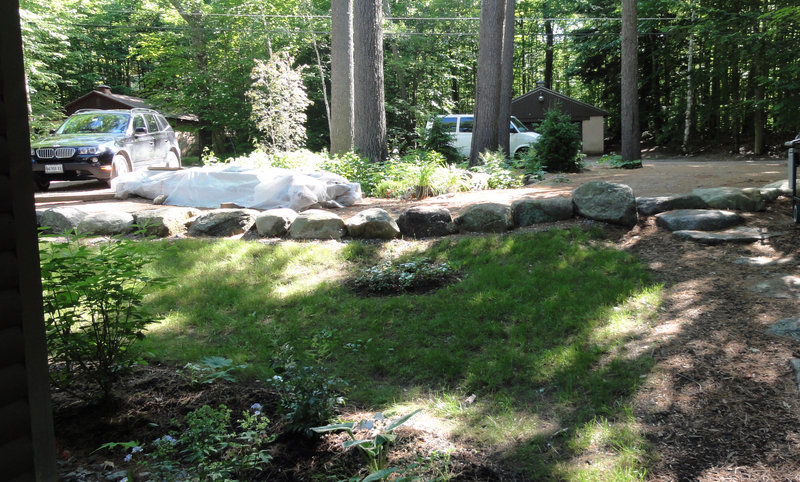Do you have long-standing erosion problems on your lakefront property? If you live around big Sebago Lake or its tributaries, matching grants are available to help address the situation.
With an old camp right on the shores of Sebago in Casco, the Greenes used to witness significant erosion during and after storms. They would see the lake water in front of their camp become silty and cloudy. “You could see the dark, earthy silt,” said Dawn Greene. “There is none of that now.”
The Greenes took advantage of matching funds from Portland Water District to help replace bare and grassy areas with native plants that hold the soil.
“Lakescaping” is a term the water district has coined for the lakeside remediation efforts. A free program by Kirsten Ness, master gardener, at 6:30 p.m. July 28 will explain Lakescaping, which incorporates easy, inexpensive and attractive methods each of us can use to help protect clean water.
By planting native plants and creating a meandering mulched path down to the water, the Greenes now have less lawn to care for, a bonus allowing more leisure time. Greene notes the improvements have required little maintenance. Although the bulk of the project was completed last year, she plans to continue planting native plants, replacing some underachieving non-natives.
Lakescaping helps both property owner and the lake. Native plants, which are the cornerstone of the Lakescaping approach, simply require less water, no fertilizers and no pesticides to thrive. They also attract beautiful butterflies, birds and wildlife.
Depending on the property’s exposure to sun and soil conditions, some common native plants recommended for the Sebago Lake region are lowbush blueberry, bearberry, winterberry and blue flag iris. Lowbush blueberry bushes are particularly favored for their strong root system, edible fruit and low growth.
Greene installed a rain garden, selecting small Serbian spruce trees and summersweet, or clethra, because they can tolerate a lot of water. She also planted inkberry along the waterfront. “The inkberry shrub is one of my favorites,” she said. “It is a background plant with evergreen foliage and a little flower.”
By contrast, lawns leading to the water’s edge have few of the benefits of a more natural shoreline and provide little wildlife habitat.
Shallow-rooted grasses don’t hold soil or prevent erosion as well as deeper-rooted shrubs and trees. They also need frequent maintenance and are often over-fertilized.
It’s actually plain old dirt that is the biggest pollutant to a water body like Sebago Lake because soil carries phosphorus into the water, which promotes algae growth that ultimately depletes oxygen levels.
In the last few years, the water district says it has helped an average of 20 property owners per year. The Greenes heard about the grant program through a neighbor who Lakescaped their property.
This year, the first 10 people to become Sebago Lakescapers will receive a free blueberry bush. Properties must be within the shoreland zone of Sebago Lake or one of its tributaries to be eligible for the gift and matching funds.
Contact the Portland Water District at sebagolake@pwd.org or 774-5961 to learn more. Matching grants of up to $1,000 are available to homeowners, and up to $2,000 are available to lake associations, commercial summer camps, and municipalities.
Funds can be used to purchase gardening supplies, plants, or other lake-friendly improvements.
To reserve a seat at the free talk on the evening of July 28 at the water district’s Ecology Center in Standish, call 774-5961, ext. 3324 or email sebagolake@pwd,org.
Don Perkins is a freelance writer who lives in Raymond. He can be reached at: presswriter@gmail.com
Send questions/comments to the editors.



Success. Please wait for the page to reload. If the page does not reload within 5 seconds, please refresh the page.
Enter your email and password to access comments.
Hi, to comment on stories you must . This profile is in addition to your subscription and website login.
Already have a commenting profile? .
Invalid username/password.
Please check your email to confirm and complete your registration.
Only subscribers are eligible to post comments. Please subscribe or login first for digital access. Here’s why.
Use the form below to reset your password. When you've submitted your account email, we will send an email with a reset code.